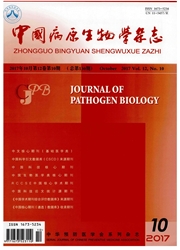

 中文摘要:
中文摘要:
目的调查云南东部高原淡水湖泊异龙湖、杞麓湖流域广州管圆线虫中间宿主、终宿主和人群感染情况,研究GIS在其中的应用价值。方法应用GIS技术,预测绘制广州管圆线虫在异龙湖、杞麓湖流域的潜在分布图。随机设调查点捕捉螺类及鼠类,检测广州管圆线虫感染情况。对当地居民进行广州管圆线虫病流行病学问卷调查,并采集血清,ELISA检测IgG和IgM抗体。应用SPSS17.0和ArcGIS10.0软件对结果进行统计和空间分析。结果建立了福寿螺和广州管圆线虫在异龙湖、杞麓湖区域分布预测图。捕获4种螺,分别为福寿螺、中华园田螺、铜锈环棱螺和琵琶萝卜螺,未检出广州管圆线虫幼虫。共捕获鼠4种,304只,所有鼠解剖心肺组织,均未发现广州管圆线虫成虫;采集鼠血清150份,IgG抗体均为阴性。共随机调查330人,回收有效问卷310份。结果显示99.35%(308人)的居民没有吃过生螺、鱼虾等,0.65%(2人)的人偶尔吃过生螺、鱼虾等;69.35%(215人)的受调查者偶尔吃不熟的螺,只有2.26%(7人)的居民经常吃不熟的螺蛳。共采集有效血样308份,IgG抗体阳性31份,阳性率为10.06%,其中少数民族居民阳性率17.17%(17/99)与汉族阳性率6.70%(14/209)相比,差异有统计学意义(χ2=8.140,P〈0.05)。31份IgG阳性血清经检测,其IgM抗体检测均阴性。居民血清IgG值空间自相关性分析显示血清值的空间分布可能是随机空间过程的结果。结论云南东部高原淡水湖泊异龙湖、杞麓湖流域仅居民血清ELISA检测IgG发现阳性标本,暂未被证实为广州管圆线虫的自然疫源地。GIS可以描述和预测广州管圆线虫的分布,分析宿主感染与地理环境之间的关系,可应用于广州管圆线虫病自然疫源地的研究,为广州管圆线虫流行动态防控策略提供理论基础。
 英文摘要:
英文摘要:
Objective To investigate the prevalence of infection with Angiostrongylus cantonensis in intermediate hosts,final hosts,and the human population in the Yi Long and Qi Lu lake basins and to examine the value of using ageographic information system(GIS)to epidemiologically investigate the prevalence of A.cantonensis. Methods A GIS was used to predict potential areas with A.cantonensis and its main intermediate host Pomacea canaliculata in the Yi Long and Qi Lu lake basins.Study sites were randomly selected.Snails and rodents were caught to determine whether or not they were infected with A.cantonensis.An epidemiological questionnaire was used to survey local residents regarding infection with A.cantonensis,and their sera were collected to detect the specific IgG and IgM antibodies against A.cantonensis using ELISA.The survey results were statistically and spatially analyzed using SPSS17.0and ArcGIS10.0. Results Potential areas with A.cantonensis and P.canaliculatain the Yi Long and Qi Lu lake basins were predicted.Four species of snails,i.e.P.canaliculata,Cipangopaludina chinensis,Bellamya aeruginosa,and Radix luteola,were noted.The larvae of A.cantonensis were not detected in these hosts.Three hundred and four rodents were caught,and adult A.cantonensis worms were not noted in rodent hearts or lungs.None of the rodent sera tested positive for antibodies according to ELISA.Three hundred and thirty residents were randomly surveyed,and 310 valid responses were received.Survey results indicated that 99.35% of the residents had not eaten raw snails,0.65% of residents occasionally ate raw snails,fish,or shrimp.Of the residents,69.35%% occasionally are slightly cooked snails while only 2.26% often ate slightly cooked Margarya melanioides snails.Of the 308 blood samples that were collected,31(10.10%)were sero-positive for IgG antibodies.The sero-positive rate in minorities(17.17%)differed significantly(χ2=8.140,P〈0.05)from that in the Han ethnicity(6.70%).Auto-correlation analysis of the spatial dis
 同期刊论文项目
同期刊论文项目
 同项目期刊论文
同项目期刊论文
 期刊信息
期刊信息
